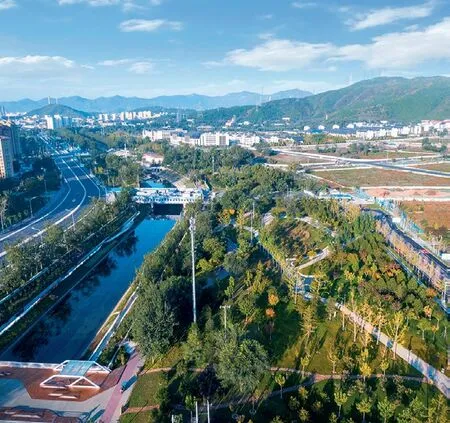绿色空间助力城市发展
2021-04-24郑曦

苏州古城东南城门称葑门,古时候葑门外是大片葑田和圩田,密布的水网交织穿城而过,出城的西北城门阊门经上塘河到大运河枫桥码头,再向西望是浅丘环绕,浅丘以西是太湖之滨。古城处在圩田水网系统之上,适应了农业生产、漕运和泄洪的需求。同时,遍布城内外的寺观宝塔、园林和名胜锚固于圩田水网浅丘之上,形成山水人文意境与诗意城市。从拙政园东园过倚虹亭西望水线,可借景北寺塔,从北寺塔西眺可见西部诸山,如天平山、灵岩山、穹窿山等。拙政园中部远香堂北临的水面上有两座岛山野趣盎然,其中一岛遍植柑橘隐喻太湖洞庭山,有亭为“待霜”。园林营造的城市山林表达出对自然山水的向往,是浅丘圩田水网本底上精神与美的升华。
随着生产方式的变革,从农业向大规模工业化发展,人口迅速增长,城市密度加大,人地关系紧张,古代城市所依存的自然本底逐渐被蔓延的城市所占据,导致城市病的增加,也带来了迷失自身特质的景观和“千城一面”的城市风貌。
今天,绿色空间所承担的生态使命,使其以更宏观的视野介入城市,从城市结构布局到区域景观体系,再到微观上的街区更新,这一支撑系统可以改变土地利用和覆被变化,增强城市碳汇效益,提升雨洪调节等生态系统功能,协调山水林田湖草与城市人居环境的关系,更有效地整合自然资源,赋予城市更高质量的发展。加拿大多伦多市制定林冠盖度达到40%目标,将林冠盖度比例指标精细分配到绿地、居住用地等每类用地内,不同用地类型按不同比例权重规定,这样保证了森林覆盖到全市范围,与城市空间广泛融合。绿色空间还有利于促进城市空间功能复合和活化,构建“融合自然的城市更新”。北京实施的“留白增绿”就是结合城市更新计划构建不同尺度的绿色空间,平安大街是一条寻找北京城文化积淀的历史画廊,最近的更新方式是在40 m宽的道路中间分车带上增加绿化带、种植大乔木,把失去的老城街道尺度找回来,增加口袋公园,与老城空间肌理更融洽。法国巴黎的香榭丽舍大街是世界上最繁华的街道之一,但近30年来,由于过度的旅游、商业、交通、污染和不透水铺装等原因,沿着大街漫步的行人中当地人仅占5%,它已经逐渐被巴黎人放弃,最新公布的改造计划是使其成为一个“非凡的花园”,包括减少一半的车辆行驶空间,将街道变成人行区和绿地,种植更多树木创造新的绿色空间,以提升空气质量,让街道变得更加亲民、柔和,提升巴黎市民对城市的热爱,成为未来新型城市生活模式的灵感之源。
相较于古代城市依托的农业水网基底,当代城市绿色空间成为城市发展的自然本底。虽然由于生产方式的变革,人文与美学所锚固的载体不同,但经过设计的园林景观依然是自然本底上的文化制品。同古代城市一样,都满足了生产生活的客观需求、人文的内涵、审美的秩序三方面的价值。意大利哲学家贝奈戴托·克罗齐(Benedetto Croce)说:“一切历史都是当代史”,无论考量的时间跨度多么久远,实际上,总是反映当前的情况并受其影响。随着当代城市向信息时代转变,生产方式又面临新的变革,在未来城市场景中,绿色空间的价值又如何表达?随着智能化的发展,市政交通等灰色基础设施会逐步系统化、紧凑化,腾出的空间可形成新的绿色空间去织补城市,在便捷智慧的基础上,核心还是营造一个健康、舒适、具有人文气息的生活空间。让城市绿色空间成为生态系统的本底,也是文化体系的孕育地,并符合时代审美,形成一个更健康的城市,才是绿色空间价值的最佳表达。

Green Space Empowering Urban Development
The southeast gate of the ancient city of Suzhou is named with “Feng”. In ancient times, outside the Fengmen Gate, there was a large area of “Fengtian” field (a kind of field land made by the siltation of Zizania roots and the sediments over time in the middle of the low land ponds) and polder fields, in-between a dense water network was interwoven through the city. Out of the city’s northwest gate Changmen Gate, the water would reach Fengqiao Pier of the Grand Canal through the Shangtanghe Canal. Looking west, the ancient city is surrounded by shallow hills and the west of the shallow hills is the shore of Taihu Lake. The ancient city is on top of the polder water network system, which has been adapted to the needs of agricultural production, water transport of grain to the capital and flood discharge. At the same time, the temples, pagodas,gardens and scenic spots all over the city and beyond are anchored on the shallow hills of the polder network, forming a city of landscape and humanistic mood of poetry. From the east garden of Humble Administrator’s Garden, one can look westward at the far-reaching water view after passing through the Yihong Pavilion, where can borrow the view of North Temple Pagoda, from which one can also see the mountains in the west, such as Tianping Mountain, Lingyan Mountain and Qionglong Mountain, etc. In the middle of Humble Administrator’s Garden, there are two islands on the water near the north of Yuanxiang Hall full of rustic charm. One of the islands is planted with citrus and has a pavilion called “Daishuang”, which is a metaphor for the Dongting Mountains in Taihu Lake. The urban landscape created by the garden expresses people’s deep yearning for natural landscape, and is the sublimation of spirit and beauty on the base of the water network of shallow hills and polder fields.
As the mode of production have been transformed from relying on agriculture to on large-scale industrialization, population grows rapidly, urban density intensifies, and the tension between people and land grows, the natural base on which ancient cities depended has gradually been taken over by sprawling cities, leading to an increase in urban diseases, a landscape that has lost its own character, and a “one-look-fits-all” urban feature.
In modern times, the ecological mission of green space is to intervene in cities with a more macroscopic vision. From the layout of urban structure to the regional landscape system, and further to the microscopic neighborhood renewal, this support system can transform land use and land cover change, enhance the benefits of urban carbon sink, improve rainfall and flood regulation and other ecosystem functions, coordinate the relationship between mountains, rivers, forests, farmlands, lakes, grasslands and urban habitat, integrate natural resources more effectively, and empower cities with high quality development. Toronto, Canada, has set a target of 40% forest canopy cover, and the proportional index of forest canopy cover is finely allocated to each type of land, such as green space and residential land. With different proportional weights specified for different land types, this move ensures that the forest covers the whole city and is widely integrated with urban space.Green space is also conducive to the promotion of urban space function compounding and activation, and the construction of“urban renewal integrating nature”. The initiative of “leaving blank and increase greenery” (leaving corresponding blank areas in urban planning to prepare space for future development, and expanding green ecological space and increase the ecological capacity of the city) implemented in Beijing is to build green spaces of different scales in conjunction with urban renewal plans. Ping’an Avenue is a historical gallery in search of the cultural deposits of Beijing,which was recently renewed by adding green belts and planting large trees in the middle of the 40-meter-wide road divider to bring back the lost scale of the old city streets and adding pocket parks to match the spatial texture of the old city. The park will be more harmonious with the spatial texture of the old city. The Champs-Élysées in Paris, France is one of the busiest streets in the world. But in the last 30 years, due to excessive tourism, business,traffic, pollution and impervious pavement, locals make up only 5%of the people strolling along the avenue, and it has been gradually abandoned by Parisians. The latest renewal plan is to turn it into an “extraordinary garden”. This initiative includes reducing the traffic space by half, turning the streets into pedestrian zones and green spaces, and planting more trees to create new green spaces to improve air quality and make the streets more accessible and gentle,which will enhance Parisians’ love for the city and become a source of inspiration for a new urban living model in the future.
In contrast to the agricultural water network on which the ancient city was based, the contemporary urban green space has become the natural base for urban development. Although the humanities and aesthetics are anchored by different carriers due to changes in production methods, the designed landscape is still a cultural artifact on a natural base. Like ancient cities, they all meet the objective needs of productive life, the connotation of humanism, and the value of aesthetic order in three ways.The Italian philosopher Benedetto Croce said, “All history is contemporary history”, and no matter how long the time span is under consideration, in fact, it always reflects and is influenced by the current situation. As contemporary cities transform into digital ones under the influence of the information age and face new changes in production methods, how will the value of green space be expressed in the future urban scenario? As intelligence develops,the gray infrastructure such as municipal transportation will be gradually systematized and compacted, and the vacated space can form a new green space to weave the city. Following the basic principle of shaping a convenient, smart city, the core is still to create a healthy, comfortable and humanistic living space. The best expression of the value of green space is to let the urban green space become the background of the ecosystem and the breeding ground of the cultural system, and to conform to the aesthetics of the times to build a healthier city.
Editor-in-Chief: Professor ZHENG Xi
January 22, 2021
